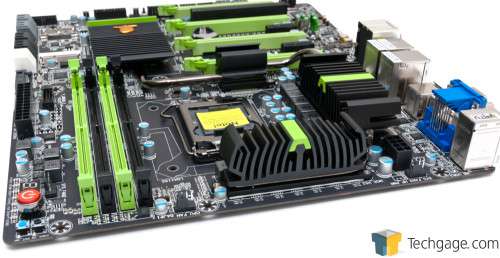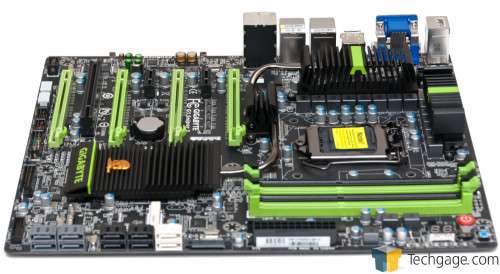- Qualcomm Launches Snapdragon 4 Gen 2 Mobile Platform
- AMD Launches Ryzen PRO 7000 Series Mobile & Desktop Platform
- Intel Launches Sleek Single-Slot Arc Pro A60 Workstation Graphics Card
- NVIDIA Announces Latest Ada Lovelace Additions: GeForce RTX 4060 Ti & RTX 4060
- Maxon Redshift With AMD Radeon GPU Rendering Support Now Available
GIGABYTE G1.Sniper 3 Motherboard Review

The motherboard market is loaded with options targeted squarely at overclockers and the general enthusiast, but finding a board – much less an entire series – dedicated to gamers is difficult. GIGABYTE realized that back in 2011, and thus its G1 series was born. In this article, we’re taking a look at the company’s current Z77 offering, the G1.Sniper 3.
Page 5 – Final Thoughts
As always, GIGABYTE has done a solid job with its latest G1.Sniper iteration to cater to the hardcore gamer. It features a good audio solution (though not X-fi, for some reason), and dual-LAN. I’d usually give credit for the Killer Ethernet inclusion, but given my experiences, there’s just nothing that impresses me about it. For that reason, I’m really glad to see an Intel NIC also included here. At least that will work under Linux, and lack of gaming enhancements aside, most gamers I know who opt for add-in NICs have gone Intel – that should say something.
The board offers a plethora of SATA and USB ports, full support for 4-way GPU for either AMD or NVIDIA, Wi-Fi for those who need it (with dual antennas – a nice touch), a solid board design and for those who might like it, cool, gamer-esque aesthetics. Hey – chances are if you’re seeking out gaming-related components, you’ll appreciate these looks.
On the EFI side, GIGABYTE’s option is fair, though not excellent. Its splashscreen remains cumbersome to use, though thankfully, that’s my biggest gripe. Once into the advanced mode, the EFI works well enough like the traditional BIOS we’ve come to expect. While the power-related options aren’t quite as in-depth as what we’ve seen on ASUS boards lately, it’s still sufficient enough for most people. Where the board does lack though is with its fan control. For those who truly appreciate fine-tuning their fan profiles, your motherboard selection is severely limited. This is another area where I hope all vendors will impress with their next-gen products.
Next, we have to talk about the software. At this point, I can imagine that some vendors hate what ASUS is doing from both an EFI and software standpoint. I hate to constantly compare one vendor to another, but ASUS has truly impressed me as of late and has forced me to realize what motherboards have been missing for a while: a quality BIOS/EFI interface and quality software. GIGABYTE’s software package and ASUS’ simply cannot be compared. GIGABYTE offers a small collection of tools that look like they were designed for children, while ASUS has produced a well-designed (even classy) suite for utmost control over your system.
The unfortunate thing for GIGABYTE is that this is the review where I decided to let loose on all of this. Had this been an MSI review, I would have done the same thing (MSI’s EFI is actually the worst I’ve personally used due to its insistence on using the mouse, along with its general layout).
As mentioned before, Intel’s next-generation of chipsets and processors are not too far off, and every board vendor has had a lot of time since the last major launch to improve-upon the areas where they’ve fallen short. I used to scoff at the BIOS and software, but ASUS has shown me what things can be like.
But let’s be clear about one thing: this board, apart from its EFI and software, is fantastic. It looks good, has a good layout that I have trouble finding something to complain about, is feature-packed, has some thoughtful design implementations for gamers, and includes Wi-Fi (even if you don’t use it right off, you sure won’t hate the fact that it’s there if you do ever end up needing it).
The one problem is that at $270, it’s not a cheap board. It has many features that help warrant that price, but unless you actually want to make use of everything it offers right off the bat, there’s no denying that there are cheaper, still good-looking options out there, even in GIGABYTE’s own line-up.
Given the fact that Intel’s next-gen “Haswell” launch is creeping up fast, this board is hard to recommend on that basis alone – but that’s not GIGABYTE’s fault. Had the board been offered at a slightly lower price, it’d be easier to recommend, because as nice as the upcoming platform may be, promises of +10% performance isn’t exactly going to matter much to most enthusiasts, especially those who might overclock.
What this board does do for me is whet my appetite for what’s to come in the future. GIGABYTE has a great base here; if it can just work on its software and EFI solutions, it could prove to be the solution to beat. For gamers who don’t care about the EFI or software solutions, your complaints will be far fewer than mine.
Support our efforts! With ad revenue at an all-time low for written websites, we're relying more than ever on reader support to help us continue putting so much effort into this type of content. You can support us by becoming a Patron, or by using our Amazon shopping affiliate links listed through our articles. Thanks for your support!







